List of parishes in Louisiana
The U.S. state of Louisiana is divided into 64 parishes in the same way that 48 of the other states of the United States are divided into counties. Alaska is the other exception, which is divided into boroughs and census areas instead.
Forty-one parishes are governed by a council called the Police Jury. The other 23 have various other forms of government, including: president-council, council-manager, parish commission, and consolidated parish/city.
Louisiana was formed from French and Spanish colonies, which were both officially Roman Catholic. Local government was based upon parishes, as the local ecclesiastical division (French: paroisse or Spanish: parroquia). Following the Louisiana Purchase in 1803, the Territorial Legislative Council divided the Territory of Orleans (the predecessor of Louisiana state) into 12 counties. The borders of these counties were poorly defined, but they roughly coincided with the colonial parishes, and hence used the same names.[1]
On March 31, 1807, the territorial legislature divided the state into 19 parishes without abolishing the old counties (which continued to exist until 1845).[2]
In 1811, a constitutional convention was held to prepare for Louisiana's admission into the Union.[3] This organized the state into seven judicial districts, each consisting of groups of parishes. In 1816, the first official map of the state used the term, as did the 1845 constitution. Since then, the official term for Louisiana's primary civil divisions has been parishes.
Listing
| Parish |
FIPS code[4] | Parish seat[5] | Established[5] | Origin | Etymology[6] | Population[5] | Area[5] | Map
|
|---|---|---|---|---|---|---|---|---|
| Acadia Parish | 001 | Crowley | 1886 | from part of St. Landry Parish. | Named for the Acadians who settled the area. | 61,773 | 658 sq mi (1,704 km2) |

|
| Allen Parish | 003 | Oberlin | 1912 | from part of Calcasieu Parish. | Henry Watkins Allen, the Confederate governor of Louisiana | 25,764 | 766 sq mi (1,984 km2) |

|
| Ascension Parish | 005 | Donaldsonville | 1807 | One of the original 19 parishes. | Named for the Ascension of Our Lord Catholic Church in Donaldsonville, Louisiana | 107,215 | 303 sq mi (785 km2) |

|
| Assumption Parish | 007 | Napoleonville | 1807 | One of the original 19 parishes. | Named for the Assumption Roman Catholic Church, the oldest in the state | 23,421 | 364 sq mi (943 km2) |

|
| Avoyelles Parish | 009 | Marksville | 1807 | One of the original 19 parishes. | The Avoyel Native American people | 42,073 | 866 sq mi (2,243 km2) |

|
| Beauregard Parish | 011 | DeRidder | 1912 | from part of Calcasieu Parish. | Confederate general P. G. T. Beauregard | 35,654 | 1,166 sq mi (3,020 km2) |

|
| Bienville Parish | 013 | Arcadia | 1848 | from part of Claiborne Parish. | Named after the founder of the city of New Orleans, Jean-Baptiste Le Moyne de Bienville | 14,353 | 822 sq mi (2,129 km2) |

|
| Bossier Parish | 015 | Benton | 1843 | from part Claiborne Parish. | U.S. Representative Pierre Bossier | 116,979 | 867 sq mi (2,246 km2) |
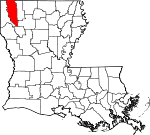
|
| Caddo Parish | 017 | Shreveport | 1838 | from part of Natchitoches Parish. | Named for the Caddo Native American people | 254,969 | 937 sq mi (2,427 km2) |
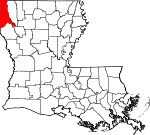
|
| Calcasieu Parish | 019 | Lake Charles | 1840 | from part of St. Landry Parish. | Calcasieu, meaning crying eagle, is said to be the name of an Atakapa Native American leader | 192,768 | 1,094 sq mi (2,833 km2) |

|
| Caldwell Parish | 021 | Columbia | 1838 | from part of Catahoula Parish and Ouachita Parish. | Named for the Caldwell family, which owned a large plantation and remains politically active in the state. | 10,132 | 541 sq mi (1,401 km2) |

|
| Cameron Parish | 023 | Cameron | 1870 | from parts of Calcasieu Parish and Vermilion Parish. | U.S. Secretary of War Simon Cameron | 6,839 | 1,932 sq mi (5,004 km2) |

|
| Catahoula Parish | 025 | Harrisonburg | 1808 | from parts of Ouachita Parish and Rapides Parish. | Catahoula Lake, formerly within the parish's boundaries and named from a Taensa word meaning big, clear lake | 10,407 | 739 sq mi (1,914 km2) |

|
| Claiborne Parish | 027 | Homer | 1828 | from part of Natchitoches Parish. | Governor of Louisiana William C. C. Claiborne | 17,195 | 768 sq mi (1,989 km2) |

|
| Concordia Parish | 029 | Vidalia | 1807 | One of the original 19 parishes. | Name is of uncertain origin; may be from an early land grant called New Concordia, from the "concord" reached by local authorities over a mutual surrender of slaves, or for a mansion called Concord which was owned by Spanish Governor Manuel Gayoso de Lemos | 20,822 | 749 sq mi (1,940 km2) |
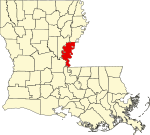
|
| De Soto Parish | 031 | Mansfield | 1843 | from parts of Caddo Parish and Natchitoches Parish. | Spanish explorer Hernando de Soto | 26,656 | 895 sq mi (2,318 km2) |
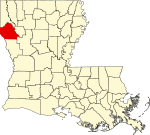
|
| East Baton Rouge Parish | 033 | Baton Rouge | 1810 | from West Florida territory. | French phrase bâton rouge meaning red stick. A red stick was used by local Native Americans to mark the boundaries between tribal territories | 440,171 | 471 sq mi (1,220 km2) |
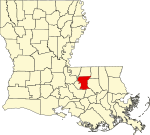
|
| East Carroll Parish | 035 | Lake Providence | 1877 | when Carroll Parish was divided. | Charles Carroll of Carrollton, the last surviving signer of the U.S. Declaration of Independence | 7,759 | 442 sq mi (1,145 km2) |

|
| East Feliciana Parish | 037 | Clinton | 1824 | when Feliciana Parish was divided. | Felicite de Gálvez, the wife of Bernardo de Gálvez, a Spanish governor of the Louisiana Territory | 20,267 | 456 sq mi (1,181 km2) |

|
| Evangeline Parish | 039 | Ville Platte | 1910 | from part of St. Landry Parish. | Acadian heroine of the poem "Evangeline" by Henry Wadsworth Longfellow | 33,984 | 680 sq mi (1,761 km2) |

|
| Franklin Parish | 041 | Winnsboro | 1843 | from parts of Carroll Parish, Catahoula Parish, Madison Parish and Ouachita Parish | Founding Father Benjamin Franklin | 20,767 | 636 sq mi (1,647 km2) |

|
| Grant Parish | 043 | Colfax | 1869 | from parts of Rapides Parish and Winn Parish. | U.S. President Ulysses S. Grant | 22,309 | 664 sq mi (1,720 km2) |

|
| Iberia Parish | 045 | New Iberia | 1868 | from parts of St. Martin Parish and St. Mary Parish. | Named by Spanish settlers in honor of the Iberian Peninsula | 73,240 | 1,031 sq mi (2,670 km2) |

|
| Iberville Parish | 047 | Plaquemine | 1807 | One of the original 19 parishes. | Explorer Pierre Le Moyne d'Iberville, the brother of Jean-Baptiste Le Moyne de Bienville | 33,387 | 653 sq mi (1,691 km2) |
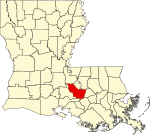
|
| Jackson Parish | 049 | Jonesboro | 1845 | from parts of Claiborne Parish, Ouachita Parish and Union Parish | U.S. President Andrew Jackson | 16,274 | 580 sq mi (1,502 km2) |

|
| Jefferson Parish | 051 | Gretna | 1825 | from part of Orleans Parish | Founding Father Thomas Jefferson | 432,552 | 642 sq mi (1,663 km2) |

|
| Jefferson Davis Parish | 053 | Jennings | 1912 | from part of Calcasieu Parish. | Jefferson Davis, president of the Confederate States of America | 31,594 | 659 sq mi (1,707 km2) |
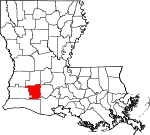
|
| Lafayette Parish | 055 | Lafayette | 1823 | from part of St. Martin Parish. | French-born American Revolutionary War hero the Marquis de la Fayette | 221,578 | 270 sq mi (699 km2) |

|
| Lafourche Parish | 057 | Thibodaux | 1807 | One of the original 19 parishes. Was named Interior Parish until 1812 and Lafourche Interior Parish until 1853. | French phrase la fourche or in English, the fork; Bayou Lafourche, or Fork Bayou, is a fork of the Mississippi River | 96,318 | 1,472 sq mi (3,812 km2) |

|
| La Salle Parish | 059 | Jena | 1908 | from part of Catahoula Parish. | Explorer René-Robert Cavelier, Sieur de La Salle | 14,890 | 663 sq mi (1,717 km2) |

|
| Lincoln Parish | 061 | Ruston | 1873 | from parts of Bienville Parish, Claiborne Parish, Jackson Parish and Union Parish. | U.S. President Abraham Lincoln | 46,735 | 472 sq mi (1,222 km2) |

|
| Livingston Parish | 063 | Livingston | 1832 | from part of St. Helena Parish. | U.S. Secretary of State Edward Livingston | 128,026 | 703 sq mi (1,821 km2) |

|
| Madison Parish | 065 | Tallulah | 1838 | from Concordia Parish. | U.S. President James Madison | 12,093 | 651 sq mi (1,686 km2) |

|
| Morehouse Parish | 067 | Bastrop | 1844 | from parts of Carroll Parish and Ouachita Parish. | Abraham Morehouse, who led the first settlers into the region | 27,979 | 805 sq mi (2,085 km2) |
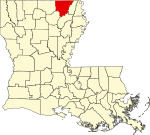
|
| Natchitoches Parish | 069 | Natchitoches | 1807 | One of the original 19 parishes. | The Natchitoches Native American people | 39,566 | 1,299 sq mi (3,364 km2) |
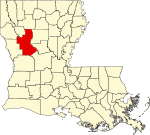
|
| Orleans Parish | 071 | New Orleans | 1807 | One of the original 19 parishes. Today coterminous with the City of New Orleans. | Named after the Duke of Orléans, the regent of France | 343,829 | 907 sq mi (2,349 km2) |

|
| Ouachita Parish | 073 | Monroe | 1807 | One of the original 19 parishes. | The Ouachita Native American people. | 153,720 | 350 sq mi (906 km2) |

|
| Plaquemines Parish | 075 | Pointe a la Hache | 1807 | One of the original 19 parishes. | A word meaning persimmons created from the Louisiana Creole French and the Mobile Native American language | 23,042 | 2,429 sq mi (6,291 km2) |

|
| Pointe Coupee Parish | 077 | New Roads | 1807 | One of the original 19 parishes. | French phrase la pointe coupée or in English, the cut-off point, which refers to a bend in the Mississippi River | 22,802 | 591 sq mi (1,531 km2) |

|
| Rapides Parish | 079 | Alexandria | 1807 | One of the original 19 parishes. | Named for local river rapids (French: rapides) | 131,613 | 1,362 sq mi (3,528 km2) |

|
| Red River Parish | 081 | Coushatta | 1871 | from parts of Bienville Parish, Bossier Parish, Caddo Parish and Natchitoches Parish. | Named for Red River, which is part of the Mississippi River watershed | 9,091 | 402 sq mi (1,041 km2) |

|
| Richland Parish | 083 | Rayville | 1868 | from parts of Carroll Parish, Franklin Parish, Morehouse Parish and Ouachita Parish. | Named for its rich land | 20,725 | 564 sq mi (1,461 km2) |

|
| Sabine Parish | 085 | Many | 1843 | from parts of Caddo Parish and Natchitoches Parish. | Named for the Sabine River and the so-called Sabine Free State | 24,233 | 1,012 sq mi (2,621 km2) |

|
| Saint Bernard Parish | 087 | Chalmette | 1807 | One of the original 19 parishes. | Saint Bernard, who was presumably the patron saint of Bernardo de Galvez, the Spanish governor who granted land to the Canary Islanders who settled the area in 1778 while Louisiana was under Spanish rule. | 35,897 | 1,794 sq mi (4,646 km2) |
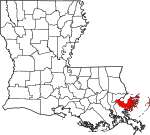
|
| Saint Charles Parish | 089 | Hahnville | 1807 | One of the original 19 parishes. | Saint Charles | 52,780 | 410 sq mi (1,062 km2) |

|
| Saint Helena Parish | 091 | Greensburg | 1810 | from West Florida territory. | Saint Helena | 11,203 | 409 sq mi (1,059 km2) |

|
| Saint James Parish | 093 | Convent | 1807 | One of the original 19 parishes. | Saint James | 22,102 | 258 sq mi (668 km2) |
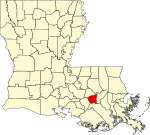
|
| Saint John the Baptist Parish | 095 | Edgard | 1807 | One of the original 19 parishes. | Saint John the Baptist | 45,924 | 348 sq mi (901 km2) |

|
| Saint Landry Parish | 097 | Opelousas | 1807 | One of the original 19 parishes. | Saint Landry | 83,384 | 939 sq mi (2,432 km2) |

|
| Saint Martin Parish | 099 | Saint Martinville | 1807 | One of the original 19 parishes. | Saint Martin | 52,160 | 817 sq mi (2,116 km2) |
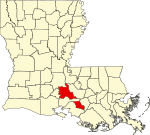
|
| Saint Mary Parish | 101 | Franklin | 1811 | from part of St. Martin County. | Saint Mary. | 54,650 | 612 sq mi (1,585 km2) |

|
| Saint Tammany Parish | 103 | Covington | 1810 | from West Florida territory. | Legendary Indian Chief Tamanend. | 233,740 | 1,124 sq mi (2,911 km2) |

|
| Tangipahoa Parish | 105 | Amite | 1868 | from parts of Livingston Parish, St. Helena Parish, St. Tammany Parish and Washington Parish. | Comes from an Acolapissa word meaning ear of corn or those who gather corn | 121,097 | 823 sq mi (2,132 km2) |

|
| Tensas Parish | 107 | Saint Joseph | 1843 | from part of Concordia Parish. | The Taensa Native American people. | 5,252 | 641 sq mi (1,660 km2) |

|
| Terrebonne Parish | 109 | Houma | 1822 | from part of Lafourche Parish. | French phrase terre bonne or in English, good earth | 111,860 | 2,080 sq mi (5,387 km2) |
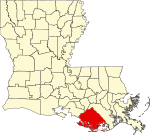
|
| Union Parish | 111 | Farmerville | 1839 | from part of Ouachita Parish. | Named for the union of states which make up the U.S. | 22,721 | 905 sq mi (2,344 km2) |
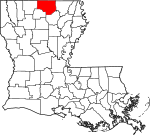
|
| Vermilion Parish | 113 | Abbeville | 1844 | from part of Lafayette Parish. | Both the Vermilion River and Vermilion Bay | 57,999 | 1,538 sq mi (3,983 km2) |
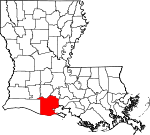
|
| Vernon Parish | 115 | Leesville | 1871 | from parts of Natchitoches Parish, Rapides Parish and Sabine Parish. | Mount Vernon, the home of George Washington, the first U.S. President | 52,334 | 1,341 sq mi (3,473 km2) |

|
| Washington Parish | 117 | Franklinton | 1819 | from part of St. Tammany Parish. | U.S. President George Washington | 47,168 | 676 sq mi (1,751 km2) |

|
| Webster Parish | 119 | Minden | 1871 | from parts of Bienville Parish, Bossier Parish and Claiborne Parish. | U.S. statesman Daniel Webster | 41,207 | 615 sq mi (1,593 km2) |

|
| West Baton Rouge Parish | 121 | Port Allen | 1807 | One of the original 19 parishes. Was named Baton Rouge Parish until 1812. | French phrase bâton rouge meaning red stick. A red stick was used by local Native Americans to mark the boundaries between tribal territories | 23,788 | 203 sq mi (526 km2) |

|
| West Carroll Parish | 123 | Oak Grove | 1877 | when Carroll Parish was divided. | Charles Carroll of Carrollton, the last surviving signer of the U.S. Declaration of Independence | 11,604 | 360 sq mi (932 km2) |

|
| West Feliciana Parish | 125 | Saint Francisville | 1824 | when Feliciana Parish was divided. | Felicite de Gálvez, the wife of Bernardo de Gálvez, a Spanish governor of the Louisiana Territory | 15,625 | 1,051 sq mi (2,722 km2) |

|
| Winn Parish | 127 | Winnfield | 1852 | from parts of Catahoula Parish, Natchitoches Parish and Rapides Parish. | Louisiana state legislator Walter Winn | 15,313 | 957 sq mi (2,479 km2) |
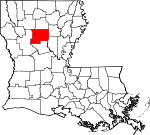
|
Former Parishes
- [Attakapas Parish, Louisiana|Attakapas Parish]
- Biloxi Parish formed in 1811 from West Florida territory. It was eliminated in 1812 when part of the former West Florida area was transferred to Mississippi Territory.[1]
- Carroll Parish formed in 1838 from part of Ouachita Parish. In 1877, it was divided into East Carroll Parish and West Carroll Parish.[1]
- Feliciana Parish formed in 1810 from West Florida territory. In 1824, it was divided into East Feliciana Parish and West Feliciana Parish.[1]
- Pascagoula Parish formed in 1811 from West Florida territory. It was eliminated in 1812 when part of the former West Florida area was transferred to Mississippi Territory.[1]
- Warren Parish formed in 1811 from part of Concordia Parish, and merged into Concordia Parish and Ouachita Parish in 1814.[1]
Parishes
The thirteen parishes defined by the Territorial Legislative Council in 1803 were:
- Acadia Parish
- Attakapas Parish
- Concordia Parish
- German Coast Parish
- Iberville Parish
- Lafourche Parish
- Natchitoches Parish
- Opelousas Parish
- Orleans Parish
- Ouachita Parish
- Pointe Coupee Parish
- Rapides Parish
In addition, Feliciana Parish was established in 1810 from West Florida territory.
Fictional parishes
- In the novels Little Altars Everywhere, Divine Secrets of the Ya-Ya Sisterhood, and Ya-Yas in Bloom, author Rebecca Wells created the fictional "Garnet Parish".
- The movie Steel Magnolias was said to take place in the fictional "Chinquapin Parish", likely a suburban parish of Shreveport, Louisiana. However, the movie was shot in Natchitoches, Louisiana, and involved several elements of culture indicative of the town and parish of the same name. For example, the annual Christmas Festival of Lights in Natchitoches is shown, as is Cajun dance styles to a distinctive country-Cajun band (Natchitoches is in the Crossroads cultural region of Louisiana, where southern Louisiana's Catholic Cajun culture meets Protestant Anglo culture of northern Louisiana.)
- Part of Walter Jon Williams' novel The Rift is set in the fictional "Spottswood Parish".
- The Southern Vampire Mysteries series of novels written by Charlaine Harris and HBO’s True Blood, which is based on the novels, take place in the fictional northwestern Louisiana "Renard Parish".
- In the movie In the Electric Mist, Deputy Jason J. Bayard was from the fictional "St. Clare Parish".
- In the DC Comics Universe, "Belle Reve Parish" is a parish in Louisiana that contains the Bell Reve Penitentiary.
References
- "Find a County". National Association of Counties. Archived from the original on 2006-11-08. Retrieved 2007-03-13. - Counties, parish seats, areas, names and date of formation of current parishes
- "Louisiana County Formation Maps". Retrieved 2007-03-13. - Formation dates and origin of parishes
- ^ a b c d e f Tabor, B. "Bryansite - Louisiana parishes".
- ^ "Louisiana Timeline - 1807".
- ^ The Admission of Louisiana into the Union
- ^ "EPA County FIPS Code Listing". EPA.gov. Retrieved 2008-02-23.
- ^ a b c d National Association of Counties. "NACo - Find a county". Archived from the original on 2008-06-04. Retrieved 2008-06-12.
- ^ Louisiana Dept. of Public Health Parish Profiles
External links
